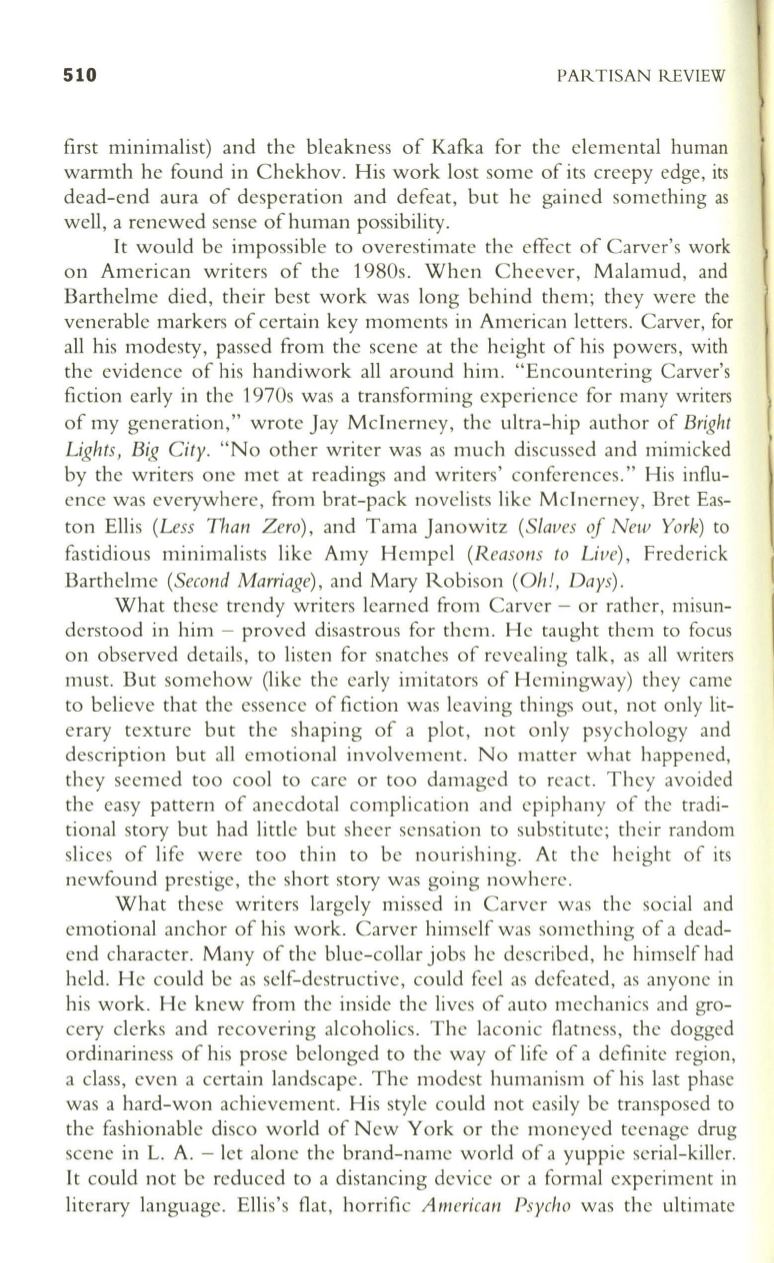
510
PARTISAN REVIEW
first minimalist) and the bleakness of Kafka for the elemental human
warmth he found in Chekhov. His work lost some of its creepy edge, its
dead-end aura of desperation and defeat, but he gained something as
well, a renewed sense of human possibility.
It would be impossible to overestimate the effect of Carver's work
on American writers of the 1980s. When Cheever, Malamud, and
Barthelme died, their best work was long behind them; they were the
venerable markers of certain key moments in American letters. Carver, for
all his modesty, passed from the scene at the height of his powers, with
the evidence of his handiwork all around him. "Encountering Carver's
fiction early in the 1970s was a transforming experience for many writers
of my generation," wrote Jay McInerney, the ultra-hip author of
Bright
Lights, Big City.
"No other writer was as much discussed and mimicked
by the writers one met at readings and writers' conferences." His influ–
ence was everywhere, from brat-pack novelists like McInerney, Bret Eas–
ton Ellis
(Less Than Zero),
and Tama Janowitz
(Slaves oj New York)
to
fastidious minimalists like Amy Hempel
(Reasons to Live),
Frederick
Barthelme
(Second Marriage),
and Mary Robison
(Ohf, Days).
What these trendy writers learned from Carver - or rather, misun–
derstood in him - proved disastrous for them. He taught them to focus
on observed details, to listen for snatches of revealing talk, as all writers
must. But somehow (like the early imitators of Hemingway) they came
to believe that the essence of fiction was leaving things out, not only lit–
erary texture but the shaping of a plot, not only psychology and
description but all emotional involvement. No matter what happened,
they seemed too cool to care or too damaged to react. They avoided
the easy pattern of anecdotal complication and epiphany of the tradi–
tional story but had little but sheer sensation to substitute; their random
slices of life were too thin to be nourishing. At the height of its
newfound prestige, the short story was going nowhere.
What these writers largely missed in Carver was the social and
emotional anchor of his work. Carver himself was something of a dead–
end character. Many of the blue-collar jobs he described, he himself had
held. He could be as self-destructive, could feel as defeated, as anyone in
his work. He knew from the inside the lives of auto mechanics and gro–
cery clerks and recovering alcoholics. The laconic flatness, the dogged
ordinariness of his prose belonged to the way of life of a definite region,
a class, even a certain landscape. The modest humanism of his last phase
was a hard-won achievement. His style could not easily be transposed to
the fashionable disco world of New York or the moneyed teenage drug
scene in
L.
A. - let alone the brand-name world of a yuppie serial-killer.
It could not be reduced to a distancing device or a formal experiment in
literary language. Ellis's flat, horrific
American Psycho
was the ultimate


